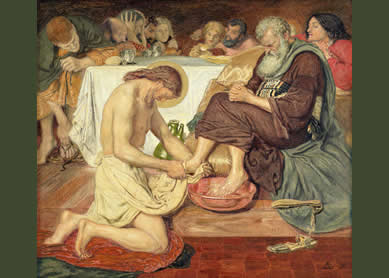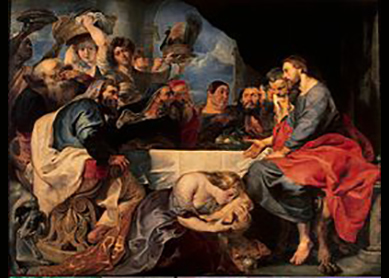According to the Synoptic Gospels, Jesus received criticism for dining with “tax collectors and sinners.” But who were these people?
Mark (2:16-17) and Matthew (9:11-13) report this controversy once, when Jesus invites a tax collector to follow him and then dines at the tax collector’s house. Luke develops this one scene (5:27-32) into a theme, adding three other controversies that arise when Jesus dines with sinners (7:36-50; 15:1-32; 19:1-10). Luke gives the impression that sinners found themselves attracted to (and welcomed by) Jesus’s ministry (15:1-2). Luke also adds a parable in which Jesus judges a tax collector as more “righteous” than a Pharisee (18:11-14). In Matthew, Jesus alludes to criticisms that he is “a glutton and a drunkard, a friend of tax collectors and sinners” (11:19, NRSV).
The association of tax collectors with sinners cries out for explanation. Scholars have long debated precisely whom the term sinners designated in the ancient world: most regard sinners as people who habitually behaved in immoral ways or in ways that contradicted widely shared religious observance. We never encounter a clear definition of sinners, a term that almost surely expressed general social disapproval. When Jesus says, “I have come to call not the righteous but sinners” (Mark 2:17; Matt 5:45; Luke 5:32), he contrasts the two groups. The category may also have socioeconomic connotations: some biblical passages link sinners to violence and exploitation (e.g., Ps 26:9-10; Prov 1:10-16; Sir 9:11), as does the influential apocalypse 1 Enoch (94:6-9).
But why group tax collectors with sinners? Tax collectors, who gathered tolls and tariffs on agricultural produce and transported goods, were widely unpopular in Roman Palestine, and no ancient source explains exactly why. Perhaps tax collectors were assumed to cheat citizens to their own benefit, as may be the case with Zacchaeus—or so the accusing crowd believes (Luke 19:7-8). People may also have regarded tax collectors as collaborators who necessarily transferred resources from ordinary Jews to Rome. Both considerations likely fueled popular animosity.
The Pharisees, concerned that all Israelites maintain high levels of religious observance, apparently regard it as inappropriate for a righteous person to consort with sinners. The gospels link the Pharisees’ complaints with those of scribes, as if we might identity two such aligned groups. Unfortunately, we know little about the scribes to whom the gospels refer. In any case, popular wisdom warned against the dangers of bad company (e.g., Sir 7:16; 8:11).
Historians debate the significance of Jesus’s association with sinners. Quite a few regard this table fellowship as a distinctive feature of Jesus’s ministry. E. P. Sanders has famously suggested that Jesus alienated his enemies by embracing sinners without requiring their repentance. That is how the Synoptic Gospels present Jesus. Although Jesus did not violate Jewish law in doing so, as some have supposed, one struggles to imagine why early Christians would invent the tradition that Jesus intentionally associated with disreputable people.
Many Christian circles insist that “all have sinned” (Rom 3:23). As a result, many readers struggle with the term sinners being applied to specific persons in biblical literature. The ancients, many of whom regarded sin as universal, nevertheless identified sinners as a discrete minority within the larger population.
Bibliography
- Sanders, E. P. The Historical Figure of Jesus. London: Penguin, 1993.
- Klawans, Jonathan. Impurity and Sin in Ancient Judaism. New York: Oxford University Press, 2000.
- Crossley, James G. Jesus and the Chaos of History. Oxford: Oxford University Press, 2015
- Siker, Jeffrey S. Jesus, Sin, and Perfection in Early Christianity. New York: Cambridge University Press, 2015.
- Rodríguez, Rafael. “Authenticating Criteria: The Use and Misuse of a Critical Method.” Journal for the Study of the Historical Jesus 7 (2009): 152-67.
- Carey, Greg. Sinners: Jesus and His Earliest Followers. Waco, TX: Baylor University Press, 2009.



